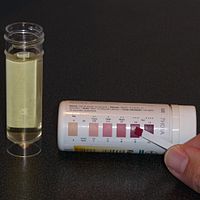
Photo from wikipedia
Background Hypertension is one of the most common chronic diseases, and dietary factors play an important role in hypertension. We examined the interaction of dietary sodium-to-potassium (Na/K) ratio and dinner… Click to show full abstract
Background Hypertension is one of the most common chronic diseases, and dietary factors play an important role in hypertension. We examined the interaction of dietary sodium-to-potassium (Na/K) ratio and dinner energy ratio on hypertension. Methods We conducted this study using data from cross-section, the National Survey for Nutrition and Adult Chronic Disease in 2015 in Inner Mongolia (China). Dietary data were collected by using 24-hour diet records with food weights across three consecutive days. Logistic regression was used to determine the interaction of dinner energy ratio and dietary Na/K ratio on hypertension. Results A total of 1,861 participants were included in this study, of those 914 individuals were hypertensive (49.1%). Dinner energy ratio and high dietary Na/K ratio were independently related to high prevalence of hypertension. A formal test showed that dinner energy ratio interacted significantly with dietary Na/K ratio on hypertension (P<0.001), with the adjusted OR (95%CI) of 1.119 (1.040-1.203). Participants whose dinner energy ratio greater than 39.1% and dietary Na/K ratio within 3.625 and 6.053 had the highest odds ratio of hypertension prevalence, with the adjusted OR (95%CI) of 2.984 (1.758-5.066), comparing with participants those dinner energy ratio within 30.2% and 39.1%, and dietary Na/K ratio less than 2.348. Conclusions Our study highlighted the interactive effect of dinner energy ratio and dietary Na/K ratio on hypertension among adults in Inner Mongolia. We advocated a balanced diet (dinner energy ratio not small or large) and a low dietary Na/K ratio for reducing the prevalence of hypertension.
Journal Title: Journal of epidemiology
Year Published: 2022
Link to full text (if available)
Share on Social Media: Sign Up to like & get
recommendations!